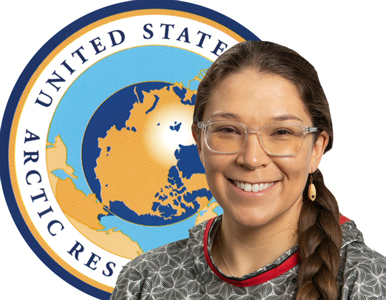
Cooperation, hard work, humility, and a responsibility to the tribe are at the heart of Iñupiaq culture. They are the same values that Liz Qaulluq Cravalho, SPA/MSOD ’16—whose ancestors have lived in northwest Alaska for 10,000 years—will bring to her two-year appointment to the US Arctic Research Commission (USARC).
Cravalho, vice president of lands for NANA Regional Corporation, which is owned by 15,000 Iñupiaq shareholders and encompasses a swath of land as large as Indiana, is one of seven commissioners appointed by President Joe Biden in late September. It’s a diverse group that reflects the heterogeneity of the region: one-third of the commissioners are indigenous, half are women, and two-thirds are residents of America’s 49th state.
“I really appreciate the opportunity to serve,” says Cravalho, who holds one of two industry seats. “In the [MSOD] program we talked a lot about our ‘unique cultural lens.’ I know I’ll be doing a lot of cross-cultural engagement in this position: working with different groups with different interests to find those sweet spots for collaboration.”
Born out of the Arctic Research and Policy Act of 1984, USARC is an independent federal agency tasked with identifying scientific research priorities for the polar region and developing the local and international partnerships necessary to implement them.
Beautiful but forbidding, the Arctic spans eight countries and 5.5 million square miles at the northernmost part of the planet. It has been inhabited by humans for nearly 20,000 years and is today home to four million residents, including about 400,000 indigenous peoples, and 5,500 animal species, all of whom are acutely vulnerable to threats posed by climate change and mining for oil and gas.
In fact, the Arctic is ground zero for climate change, with temperatures warming three times faster than the rest of the world.
Cravalho, who returned to her native Kotzebue, Alaska, about 11 years ago—commuting to DC for her master’s program—is witness to the everyday ways climate change is wreaking havoc on the environment and the economy.
Last year, for example, thawing permafrost prompted the massive Red Dog Mine, located 80 miles north of Kotzebue on NANA-owned land, to shell out $20 million to build a new wastewater treatment system to prevent more sediments and minerals from being released into the watershed. The mine has generated $500 million for NANA shareholders since it opened in 1989. But it’s also sparked conflict with locals when the shipping window has been adjusted as the result of severe weather, thus making conditions more difficult for hunters.
One of the biggest challenges for Cravalho, who’s worked “at the intersection of people and policy” at NANA since 2013, is getting Americans, many of whom view the Arctic as too frozen and too remote to be of consequence, to understand what’s at stake—for the land and the people whose culture, traditions, and very survival are inexplicably tied to it.
“How do we get people to care? That’s the million-dollar question,” she says with a warm laugh. “Often it comes down to the storytelling and tapping into what people care about.”
Like their cars. Red Dog Mine is one of the world’s largest producers of zinc—50 pounds of which are in every vehicle on the road.
“That can get people’s attention real quick,” Cravalho says.
Such are the insights and expertise she’ll bring to the US Arctic Research Commission—along with an abiding love and respect for “the people, the traditions, the beautiful country.”
“I’m one person in the long arc of history, and I’ll be leaning on others for their advice and encouragement and connecting with elders to ensure we’re all moving in the right direction together.”